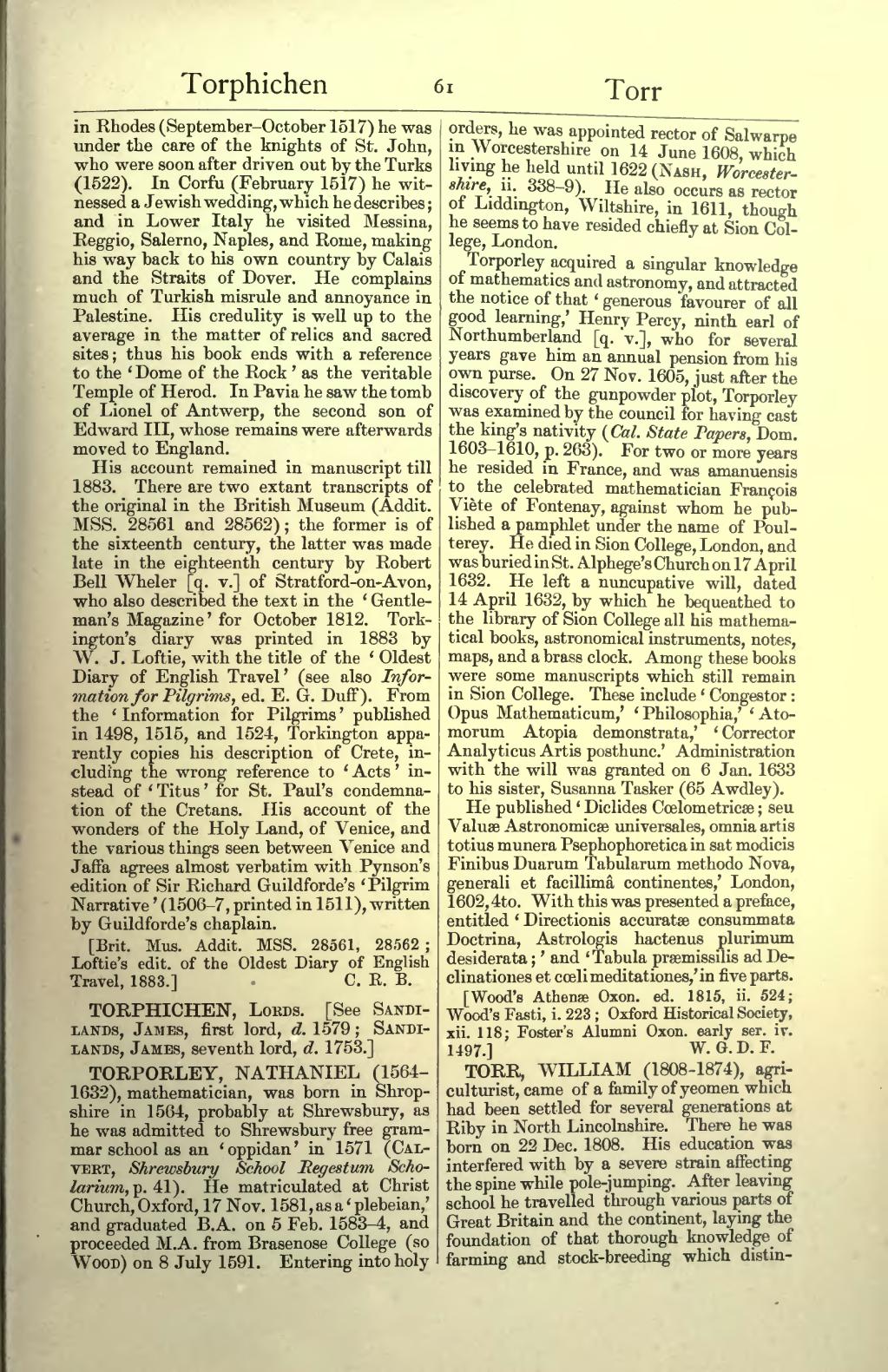in Rhodes (September-October 1517) he was under the care of the knights of St. John, who were soon after driven out by the Turks (1522). In Corfu (February 1517) he witnessed a Jewish wedding, which he describes; and in Lower Italy he visited Messina, Reggio, Salerno, Naples, and Rome, making his way back to his own country by Calais and the Straits of Dover. He complains much of Turkish misrule and annoyance in Palestine. His credulity is well up to the average in the matter of relics and sacred sites; thus his book ends with a reference to the ‘Dome of the Rock’ as the veritable Temple of Herod. In Pavia he saw the tomb of Lionel of Antwerp, the second son of Edward III, whose remains were afterwards moved to England.
His account remained in manuscript till 1883. There are two extant transcripts of the original in the British Museum (Addit. MSS. 28561 and 28562); the former is of the sixteenth century, the latter was made late in the eighteenth century by Robert Bell Wheler [q. v.] of Stratford-on-Avon, who also described the text in the ‘Gentleman's Magazine’ for October 1812. Torkington's diary was printed in 1883 by W. J. Loftie, with the title of the ‘Oldest Diary of English Travel’ (see also Information for Pilgrims, ed. E. G. Duff). From the ‘Information for Pilgrims’ published in 1498, 1515, and 1524, Torkington apparently copies his description of Crete, including the wrong reference to ‘Acts’ instead of ‘Titus’ for St. Paul's condemnation of the Cretans. His account of the wonders of the Holy Land, of Venice, and the various things seen between Venice and Jaffa agrees almost verbatim with Pynson's edition of Sir Richard Guildforde's ‘Pilgrim Narrative’ (1506–7, printed in 1511), written by Guildforde's chaplain.
[Brit. Mus. Addit. MSS. 28561, 28562; Loftie's edit. of the Oldest Diary of English Travel, 1883.]
TORPHICHEN, Lords. [See Sandilands, James, first lord, d. 1579; Sandilands, James, seventh lord, d. 1753.]
TORPORLEY, NATHANIEL (1564-1632), mathematician, was born in Shropshire in 1564, probably at Shrewsbury, as he was admitted to Shrewsbury free grammar school as an 'oppidan' in 1571 (Calvert, Shrewsbury school Regestum Scholarium, p. 41). He matriculated at Christ Church, Oxford, 17 Nov. 1581, as a 'plebeian,' and graduated B.A. on 5 Feb. 1583-4, and proceeded M.A. from Brasenose College (so Wood) on 8 July 1591. Entering into holy orders, he was appointed rector of Salwarpe in Worcestershire on 14 June 1608, which living he held until 1622 (Nash, Worcestershire, 338-9). He also occurs as rector of Liddington, Wiltshire, in 1611, though he seems to have resided chiefly at Sion College, London.
Torporley acquired a singular knowledge of mathematics and astronomy, and attracted the notice of that 'generous favourer of all good learning,' Henry Percy, ninth earl of Northumberland [q. v.], who for several years gave him an annual pension from his own purse. On 27 Nov. 1605, just after the discovery of the gunpowder plot, Torporley was examined by the council for having cast the king's nativity (Cal. State Papers, Dom. 1603-1610, p. 263). For two or more years he resided in France, and was amanuensis to the celebrated mathematician François Viète of Fontenay, against whom he published a pamphlet under the name of Poulterey. He died in Sion College, London, and was buried in St. Alphege's Church on 17 April 1632. He left a nuncupative will, dated 14 April 1632, by which he bequeathed to the library of Sion College all his mathematical books, astronomical instruments, notes, maps, and a brass clock. Among these books were some manuscripts which still remain in Sion College. These include 'Congestor: Opus Mathematicum,' 'Philosophia,' 'Atomorum Atopia demonstrata,' 'Corrector Analyticus Artis posthunc.' Administration with the will was granted on 6 Jan. 1633 to his sister, Susanna Tasker (65 Awdley).
He published 'Diclides Coelometricae; seu Valuae Astronomicae universales, omnia artis totius munera Psephophoretica in sat modicis Finibus Duarum Tabularum methodo Nova, generali et facillima continentes,' London, 1602, 4to. With this was presented a preface, entitled 'Directionis accuratae consummata Doctrina, Astrologis hactenus plurimum desiderata;' and 'Tabula praemissilis ad Declinationes et coeli meditationes,' in five parts.
[Wood's Athenæ Oxon. ed. 1815, ii. 524; Wood's Fasti, i. 223; Oxford Historical Society, xii. 118; Foster's Alumni Oxon. early ser. iv. 1497.]
TORR, WILLIAM (1808–1874), agriculturist, came of a family of yeomen which had been settled for several generations at Riby in North Lincolnshire. There he was born on 22 Dec. 1808. His education was interfered with by a severe strain affecting the spine while pole-jumping. After leaving school he travelled through various parts of Great Britain and the continent, laying the foundation of that thorough knowledge of farming and stock-breeding which distin-

